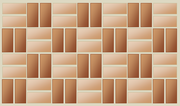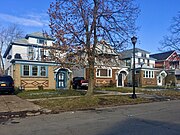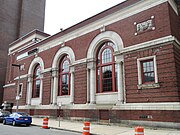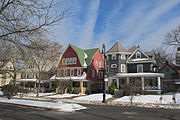Draft:Tapestry brick
(Notes by Doncram): Tapestry brick (currently a redlink) is used 40 or so times in NRHP and other articles in Wikipedia. (see this search's results). There are currently 4 inbound links to it from mainspace articles.
An article would be helpful right now for me in writing Draft:R.T. Frazier House, where there is both "tapestry brick" and stonework in its porch which have two or more stone colors, but I think the two are different different, I think the brick is in wall above. --Doncram (talk) 18:53, 1 September 2022 (UTC)
This topic should be defined briefly in the existing Brickwork article, which currently does not use the word "tapestry". A separate article could usefully show a lot of examples though.
How many distinct meanings are there? Possibilities:
Tapestry brick is a type of brick with rough edges. This type of brick has been manufactured by Fiske Company, which attempted to trademark the term.[1][2] The Dictionary of Ceramic Science and Engineering defines tapestry brick as "a brick having a rough, unscored, textured surface."[3]
- This could be the meaning in New York Times 2006 article "The Astor Legacy in Brick and Stone": Astor's " first development project appears to have been a chaste tapestry-brick warehouse at 4 Ninth Avenue, which he completed in 1913."[4] Should be able to get this article. That address is in the now-cool meatpacking district, and from Google Streetview (does this direct link to Streetview there work? it appears the building, or at least its facade, survives, although there has been modern expansion upwards. The brick front of the 1? or 2? story building could be described as chaste. Some variation in coloring of bricks, but there is not a color pattern. Could mean just rough individual bricks.
Alt meaning: Tapestry brick is the brickwork/wall built of individual tapestry bricks, simply done. Together it makes a nice appearance. That's what I thought to be the usage in Draft:R.T. Frazier House (but maybe it just said "tapestry brick wall" which can be interpreted to mean the individual bricks? Check its NRHP document's wording.)
Alt meaning: Tapestry brick is the brickwork/wall built of same-colored bricks, which can be smooth but often are individual rough tapestry bricks, and are put together in basket weave bond or other decorative pattern.
- Per the Free Dictionary, it is: "Face brick that is laid in a decorative pattern with a combination of vertical, horizontal, and diagonal elements, such as a basket-weave bond."
- Is this the meaning of Mike Jackson in Architect (magazine), who says tapestry brick is especially associated with Arts & Crafts / Arts & Crafts architecture: "The phrase 'tapestry brick' indicates the use of brick to create a pattern effect, a style that is often associated with rough-textured brick made popular in the early 20th century. This type of brick was frequently featured in Arts & Crafts architecture, but could also be found in various styles of commercial and residential buildings of the era."[5] That quote doesn't mention color.
4. Tapestry brick is the brickwork/wall built of two or more colors of brick, which can be smooth, which make deliberate patterns out of the colors.
- A short article, "A Guide to Understanding and Maintaining Historic Brick in Brooklyn", in Brownstoner: In the 1900s it is implied, "A style known as tapestry brick covered facades with geometric patterns such as diamonds and basketweave using two or more colors of brick, such as brown, dark gray and cream."[6] This has no author, is just a consumer magazine article. It clearly says pattern made of colors, but it is not a reliable source for defining the term.
- This is usage apparently in Jonathan D. Taylor's PhD? thesis which defines a new term, a Tapestry brick dwelling, as a thing which exists Brooklyn; e.g. brick row houses (can it ever be standalone houses?) in Flatbush, Brooklyn. The term as defined involves patterned brick plus other features.[7]
- Comment: the simplistic patterns aren't necessarily pretty, to my eye.
5. Can tapestry brick be the brickwork/wall built of two or more colors of brick, which can be smooth, put together randomly?
6. Can "tapestry brick" as in a tapestry of bricks now be a meaning? Maybe not a meaning but cover it as a related marketing name/gimmick in a footnote?
- Hang your own Tapestry Brick Wall hanging. The term Tapestry Brick is being co-opted, cleverly enough, using term "Brick Tapestry" (or do they ever say "Tapestry Brick"? to market a fabric printed with a brick wall image that can be hung, and voila you have a cool living room in one of the NYC apartments that don't actually have a real bare brick wall deliberately exposed by a renovation.
7. Not arguing this is a real definition, but I wondered: "Is it any brick face meant to be nice to look at? Maybe it is in effect that, it is when a brick surface is decorative, or is presented forward to be looked at? As opposed to being merely functional." And i wondered how does it compare to a Curtain wall (architecture)? A curtain wall can be made of brick, probably patterned or not. A curtain wall can be, is, functional, it keeps the water out, it forms the exterior sheathe, even though it is not load-bearing/"structural". Yes, that wording is sort of right: there is "Load-Bearing Brick Walls: Building With Structural Brick" by Jim Tann in that Masonry Design Magazine.
There is Tapestry Brick Work, a book from 1909. Fiske & Company J. Parker & B. Fiske, 1909 - Bricks - 39 pages. And Tapestry Brick Fireplaces (1921) also by Fiske & Company. This 1911 edition of Tapestry Brick Fireplaces permits me to scroll and see examples, good. And then This Old Home journal article here includes b&w design by Fiske & Company, perhaps for Model A in their book.
- Images from that book remind me of a brick fireplace with brick work going up to ceiling i think, in a house designed by Arts & Crafts architect Ward Wellington Ward in Syracuse NY. Hmm, it was Sanford House (Syracuse, New York), which was covered in a fairly big newspaper article (not mentioned in article) and was open for a showing in December 2007 apparently, very very early for me in Wikipedia. I had created a few NYS NHL articles earlier, but was inactive in 2007. My pics that are in article do not include a pic of the fireplace(s), and i dunno if I could find my pics taken back then. :( --Doncram (talk) 17:37, 13 September 2022 (UTC)
- That house built in 1913. I bet the fireplace i recall was exactly one of those designs in 1909 Fiske book. It was in basement level den type room designed by the architect, perhaps having a pool table, which I think had windows and a door opening out to the back as the house was built on a hill. It might have been dark there, and/or I might have run out of camera battery, so I might not have gotten a photo at all. I could possibly get back there, and could request permission to tour the house in advance. --Doncram (talk) 21:08, 13 September 2022 (UTC)
Alamy stock photos gets some hits.
Stuff from MB[edit]
- the thesis by Taylor, calls Tapestry Brick a new architectural style
- good background, says T.B. is any brick with a rough finish, contrasted to traditional smooth red brick. Fiske trademarked the name.
- Yes, interesting. That is by Paul Potts. Funny there is a International Brick Collectors Association: International Brick Collectors Association. Potts names "two papers that were of invaluable help as I researched my bricks":
- "Tapestry Brick Dwellings: The Emergence of a Residential Type in Brooklyn" by Jonathan Taylor [the thesis], and
- "Early 20th Century 'Face Brick' as a National Industry" by Julie Rosen here is a copy of Rosen book at Columbia University Commons, probably the copy that Jonathan Taylor read Long abstract given there does not use word "tapestry", although it is about industry built on deliberate usage of different textures and colors of brick. Rosen does mention that regular brick, weathered, becomes rough, so it's not always easy to tell if original was rough individual tapestry bricks, in restorations.
- and states "I also want to recommend the wonderful book "The Good Neighbor" by Maxwell King, which is about Fred Rogers ("Mister Roger's Neighborhood"). Oh, the connection he speaks of is about getting "A brick connected to my hero: Mr. Rogers." He sought and got a McFeely brick. Noted "that Fred McFeely Rogers’ grandparents, the McFeely’s, made their fortune making McFeely firebricks. Mr. Rogers’ father ran the McFeely Brick Company when Fred was a boy". And concludes "Mr. Rogers asked us to be the best we can be and to see that potential in others. What can we do to make this world a better and more just place? Let us start by looking at how it is built. And let us also look to the example of Mr. Rogers by creating buildings, cities, and systems that help people. So that we might better our world – for everyone." If the McFeely brick is a tapestry brick, maybe Mr. Rogers can be mentioned, at least in a note?
- Yes, interesting. That is by Paul Potts. Funny there is a International Brick Collectors Association: International Brick Collectors Association. Potts names "two papers that were of invaluable help as I researched my bricks":
- more on fire places
- house with T.P. facade
- Fiske advert
- another Fiske ad
- multi-page Fiske ad
- Bungalow Magazine article
- NY architect article partial written by Fiske?
Gallery[edit]
Includes some pic candidates and some pics that help accomplish research.
-
Double basket weave bond is just a way of laying brick, whether smooth or rough?
-
(Triple?) Basket weave bond. Term applies just to top row of (smooth) bricks.
-
Free Quaker Meeting House. Just the fact of using two colors, in such a simple pattern, is that enough for this to be T.B.?
-
Maison en brique
-
Davidson Avenue, Buffalo, New York
-
North Hall - Massachusetts College of Art and Design
-
Stanwell St. Mary V clock
Looking for any images of "Tapestry brick house" in Brooklyn:
-
Masonry (brick?) row houses in Bedford-Stuyvesant, in Brooklyn. These do not seem to be the "Tapestry brick houses" of the dissertation.
-
Flatlands Ave E 47
-
Houses in Flatbush, aka "Alphabet City". No brick ones. From Commons:Category:Houses in Flatbush
-
Another house in Flatbush, not brick.
The Polychrome Historic District showed up in some searches but does not involve tapestry brick:
-
In Polychrome Historic District, appears to be tilework not brickwork
There are 34 articles currently in Category:Brick manufacturers and 6 in Category:Brickworks in the United States. Maybe Fiske & Co. article is needed/justified, and could be a 2nd article in a double DYK?
References[edit]
- ^ Paul Potts in "A sit down with the brick boss while quarantined"
- ^ Paul Potts. "A sit down with the brick boss while quarantined". Masonry Design Magazine.
- ^ https://books.google.com/books?id=EbHaBwAAQBAJ&dq=what+is+%22tapestry+brick%22&pg=PA44
- ^ "The Astor Legacy in Brick and Stone". New York Times. September 10, 2006.
- ^ Mike Jackson (March 1, 2018). "The Building Blocks: A Brief History of Brick". Architect.
The phrase "tapestry brick" indicates the use of brick to create a pattern effect, a style that is often associated with rough-textured brick made popular in the early 20th century. This type of brick was frequently featured in Arts & Crafts architecture, but could also be found in various styles of commercial and residential buildings of the era.
- ^ "A Guide to Understanding and Maintaining Historic Brick in Brooklyn".
- ^ Jonathan D. Taylor (2013). "Tapestry Brick Dwellings: The Emergence of a Residential Type in Brooklyn". Columbia University Commons. doi:10.7916/D8JQ10CJ.
{{cite journal}}: Cite journal requires|journal=(help)
What categories apply in Wikipedia and in Commons, and are there photos with examples?
There exists Commons:Category:Brickwork details, including:
- Commons:Category:Brick wall close-ups showing less than 10 bricks
- Commons:Category:Brick walls by brickwork bond
- Commons:Category:Brick walls with ornamental brickworks
- Commons:Category:Brickwork patterns
There exists Commons:Category:Brick buildings by country and by color Commons:Category:Orange brick buildings by country, Commons:Red brick buildings by country, Commons:White brick buildings by country, Commons:Yellow brick buildings by country?
I browsed in categories and found a few pic candidates, put into gallery above.
For the "Tapestry brick house" in Flatbush I looked in Commons:Category:Brick buildings in Brooklyn, maybe that is only non-residential, and I browsed in Commons:Category:Houses in Brooklyn.

















